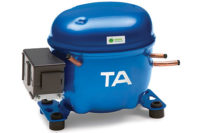Officials at various booths said the longer 22 remains readily available, the more likely it will be that 410A eventually catches on before 407C and becomes the long-term refrigerant of choice.
In refrigeration, when HCFC-22 is not used, HFC-404A and HFC-507 are the choices, with the scale tipped toward 404A. HCFC-based interims still remain viable.
The major refrigerant manufacturers noted that decisions of which refrigerant to use should be based on specific applications and after consultation with compressor makers and refrigerant producers.
Likewise, all expressed awareness of research on the use of the HC refrigerant (CO2) as a possible alternative to HFCs should politics cause a phaseout of HFCs. But all said they prefer to campaign to preserve HFCs as a long-term solution.
Word From the Trenches
In the booths,Honeywell Genetron(Morristown, NJ) billed itself as “a knowledgeable refrigerant partner that can help your business make the transition to HFCs.”Atofina (Philadelphia, PA), formerly known as Elf Atochem, promoted its commitment to HFCs by announcing an increase in production of 134a at its plant in France. The startup of an HFC-32 plant in Spain was part of the company’s effort to make itself “the largest producer of HFC-32 in the world.” R-32 is one of the refrigerants in the 407C blend.
DuPont (Wilmington, DE) offered Q&A literature on a number of the newer refrigerants.
Among overseas exhibitors of refrigerants was HRP Refrigerants Ltd. of England, which billed itself as “the leading company in the United Kingdom offering a fully integrated refrigerant service.” The company said it could ship worldwide.
From France came Calorie, which claimed “a competitive advantage for your national markets” and “fast turnaround” because of its presence in 85 countries.
Copeland Corp. (Sidney, OH) joined the focus on 410A. It added to its website (www.copeland-corp.com) a section called “the R-410A Knowledge Site.”
Chad Severson, Copeland’s director of marketing, said, “Our research findings support R-410A as the best long-term solution to R-22.”
The site is said to include audio-video material, reports from contractors who have worked with the refrigerant, frequently asked questions, and white papers on a number of new refrigerants.
Blends and Oils
A scattering of companies continued to show refrigerant blends billed as near drop-in replacements for CFC-12. The products came in a narrow range, sometimes with just a shift in percentage makeup. For the most part, each exhibitor had a single product to sell and each claimed it was best for replacing R-12.For example, Whirlpool featured Appliance Care Products R-414A, a mixture of R-22, -124, -142b, and -600A. The product, according to the company, “replicates the operating characteristics of R-12 as well as or better than any other replacement refrigerant on the market today.”
ICOR International (Indian-apolis, IN) showed R-414b (a.k.a. “Hot Shot”). The “b” means there is a slight shift in the percentages of the same refrigerants as in 414A. The result, according to ICOR, makes R-414b “technically superior to any other refrigerant in the market today.”
Do away with 22 and substitute HFC-134a and you have R-416A from Aspen Refrigeration Products and ICD Intercool Distribution (Marietta, GA). According to ICD, “It outperforms the rest” and “is better for systems than R-22 based blends.”
Among companies calling attention to oils was Witco (Greenwich, CT). It highlighted synthetic oils formulated with polyolester-based stocks and additives, as well as naphthenic mineral oils for use with long-term and interim refrigerants.
Also with detailed information on oils was BVA (Wixom, MI), with a stress on naphthenic base stocks for use with refrigeration, air conditioning, and heat pumps.
Refrigeration Technologies (Fullerton, CA) had information on different ways to test oils, such as “milking the system for oil” and testing oil “outside a system.”
Alco Controls (St. Louis) showed how to control oil levels electronically with its TraxOil. The product is said to meet today’s needs for more precise and reliable control than with traditional mechanical devices. It can be used with both low- and high-pressure oil management systems.






